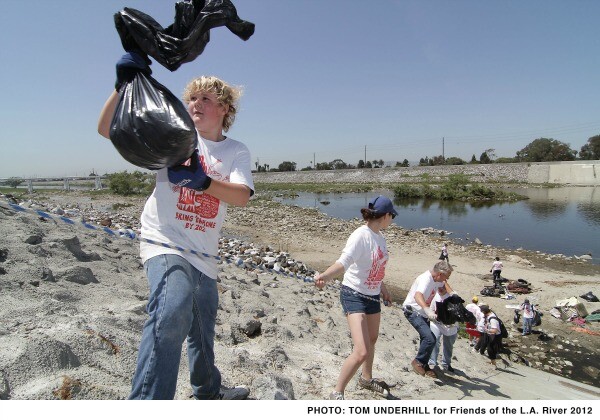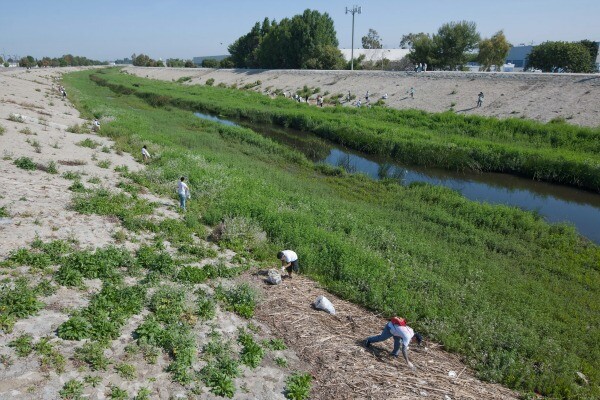The Great River Cleanup: The Los Angeles River Needs You

This May 18th, roughly three thousand volunteers will drag nearly twenty-five tons of trash from the Los Angeles River for the 24th annual Friends of the LA River (FOLAR) Great LA River Cleanup. Since the first FOLAR-run river cleanup in 1990, the L.A. River waterway has blossomed from an overlooked, concrete eyesore to an up-and-coming recreational waterway.
FoLAR's first river cleanup was simply thirty volunteers working together in Los Feliz, and since then, the event has grown and grown. Three thousand volunteers participated in last year's cleanup at fifteen sites ranging from the Sepulveda Basin to Long Beach.
Late spring is an ideal time to hold this event. Heavy rains in the winter bring trash down the river from the San Gabriel foothills. Some of the trash makes it out to sea, but much of it stays in the river. "As the water lowers, what's in the water in that spot stays," says Edie Pearl, long-time FoLAR volunteer and Compton Creek Site Captain. She compares the process to the formation of a bathtub ring. "As [the water] goes down, it leaves a film along the side of the tub that stays because it's heavier than water going out."

FoLAR has conducted trash sorts at five sites along the river since 2004. According to FoLAR's research, plastic film has consistently been the leading source of trash in the river. Plastic film includes food packaging, such as candy wrappers, and plastic grocery bags. Thanks to the California Redemption Value (CRV) program, glass and cans are not a major source of trash in the LA River.
FoLAR volunteers are, fortunately, not the only forces fighting trash in the river. Since 2001, the EPA has mandated a Trash Total Daily Maximum Load (TTDML) for the river, requiring cities in Southern California to reduce their trash contributions by 10% each year with a goal of zero trash emissions by 2015. This program has been successful in large part thanks to catch basins that prevent trash in the storm water system from entering the river.
Plastic bag bans in L.A. County have also helped cut down on the quantity of trash in the river. "[The quantity of] plastic bags is down," Pearl says. "It's noticeable."

But Pearl cautions that a plastic bag ban is not enough. Although the river is much cleaner overall than when she first started volunteering, Pearl warns, "We have to remain diligent and aware."
The Great LA River Cleanup not only benefits the river in that volunteers remove trash, but in that it provides a chance for Angelenos to get to know the river. "When people get to know the river," Karin Flores, FoLAR outreach coordinator, says, "they become stewards and advocates. That awareness helps the river, as well."
Volunteers who want to stay involved with FoLAR can volunteer to staff information tables at festivals and other events. According to Flores, "The simplest way to start helping us is to spread the word."
FoLAR wants to make the clean-up as green as possible, and volunteers can help by bringing their own reusable water bottle, bringing a clean five-gallon bucket, and carpooling or taking public transportation to a cleanup site. FoLAR will provide volunteers with cloth gloves, but it's a good idea to bring your own gloves if at all possible.
FoLAR encourages volunteers to wear sturdy shoes and sunscreen, and Flores also recommends bringing a grabber arm and boots if you have them. All volunteers will receive a free raffle ticket to enter for the chance to win cool prizes donated by sponsors such as Patagonia and Paramount Pictures, and volunteer certificates will be available.





